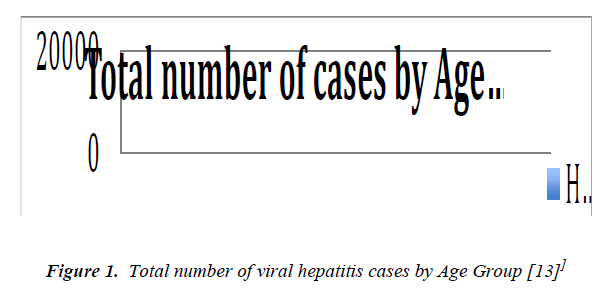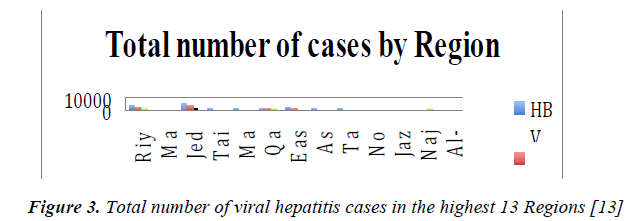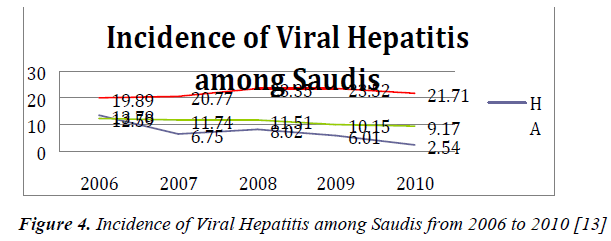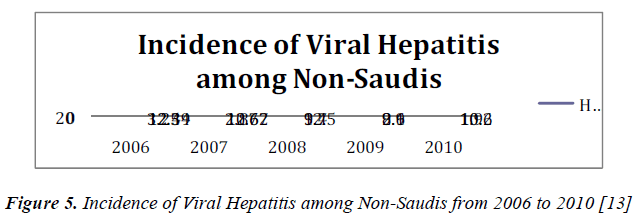ISSN: 0970-938X (Print) | 0976-1683 (Electronic)
Biomedical Research
An International Journal of Medical Sciences
- Biomedical Research (2013) Volume 24, Issue 3
Profile of viral hepatits in Saudi Arabia.
Department of Pediatrics, College of Medicine, King Saud University, Riyadh, Saudi Arabia
- *Corresponding Author:
- Abdulmajeed Abdulrahman Alshabanat
Department of Pediatrics College of Medicine
King Saud University P.O. 2925
Riyadh 11461 Saudi Arabia
Accepted May 01 2013
The study was conducted to investigate the profile of hepatitis in Kingdom of Saudi Arabia, and to determine which age group hepatitis viruses most commonly infect. The epidemiology of viral hepatitis in Saudi Arabia hasundergone major changes, concurrent with major socioeconomicdevelopments over the last two to three decades.This disease represents a major public health problem in Saudi Arabia resulting in the need for considerable healthcare resources. A retrospective cross sectional analysis of the reported cases of viral hepatitis was conducted based on the reports of The Ministry of Health in Saudi Arabia about Hepatitis A, B and C infections in all regions from the period of January 2006 to December 2010. The study demonstrated that incidence of viral Hepatitis is decreasing, except for Hepatitis B that showed minimal increase. Of hepatitis A, B, and C, Hepatitis B virus (HBV) was the most predominant type, accounting for (53%) of the cases, followed by Hepatitis C virus (HCV) (30%) and HAV (17%).HAV infection predominates in children (5–14 years) with 60% of viral hepatitis cases, HBV in young adults (15–44 years) with 69% of viral hepatitis cases, and HCV in older adults (>45 years) with 59% of viral hepatitis cases.Despite significant changes in the prevalence of viral hepatitis A, B and C, it remains a major public health problem in Saudi Arabia, however it showed a significant decline in the last two decades that could be attributed to the vaccination programs and the improved health facilities. Further researches are needed to identify the risk factors making a specific age group or a specific region in Saudi Arabia targeted for a specific type of hepatitis viruses.
Keywords
Hepatitis, Saudi Arabia, epidemiology.
Introduction
Worldwide, approximately 2 billion people have been exposed and 240 million people are chronically infected with hepatitis B virus (HBV) and about 150 million individuals are currently infected with the hepatitis C virus (HCV) and about 1.4 million new hepatitis A virus infections occur globally each year [1-4].
An estimated 57% of cases of liver cirrhosis and 78% of cases of primary liver cancer result from hepatitis B or C virus infection [5]. WHO estimates that around 4.3 million persons are infected with HBV and 800 000 persons with HCV each year in in the Eastern Mediterranean Region, with more than 75% of cirrhosis and hepatocellular carcinoma (HCC) cases are attributed to chronic hepatitis B virus (HBV) or hepatitis C virus (HCV) infection in that region [6,7]. In The Kingdom of Saudi Arabia, HBV and HCV are major causes of hepatocellular carcinoma and liver diseases requiring liver transplantation, causing an increase in the need for considerable healthcare resources [8,9,10].
HAV cause a mild disease and unlike HBV and HCV it does not cause chronic liver disease and is rarely fatal. The disease is closely associated with poor education, lack of safe water, inadequate sanitation and poor personal hygiene [11,12].
Methods
A retrospective cross sectional analysis of the reported cases of viral hepatitis was conducted based on the reports of The Ministry of Health in Saudi Arabia about Viral Hepatitis A, B and C infections in all regions of Saudi Arabia from the period of January 2006 to December 2010. In this study, we looked for incidence of viral hepatitis infection, and which age group is most commonly infected.
Statistical package for social sciences (version 19.0)* was used to process the data and analyze it. Analyses of the data included running χ2 tests for each region in Saudi Arabia,and for each age group that had the infection. All these were applied to assess the statistical relationship. A P-value < 0.01 was considered statistically significant.
Results
During the period from January 2006 to December 2010, the laboratories of the Saudi Ministry of Health reported a total of 44,679 cases of viral hepatitis. HBV was the most frequently reported (n = 23705, 53%), followed by HCV (n = 13408, 30%) and HAV (n = 7566, 17%).
The age group of viral hepatitis cases was significantly different (p < 0.001), with HBV mostly affecting the age group (15 – 44 years) with total number of 16250 cases that represent 69% of HBV cases, followed by HCV in the oldest (+45 years) with total number of 7868 cases that represent 59% of HCV cases, then HAV in the youngest (5 – 14 years) with total number of 4555 cases that represent 60.2% of HAV cases (Figure 1).
The number of cases reported showed a variation for HBV with total number of 4264 in 2006 that increased to reach 5066 cases in 2008 and then started to decrease to 4854 cases in 2010, and for HCV it showed a decreasing pattern with 2964 cases in 2006 to 2733 cases in 2008, to 2448 cases in 2010, and HAV showed the same pattern as HCV but with more steady decline in the number of reported cases with 2631 cases in 2006 to 1678 cases in 2008, then 616 cases in 2010 (Figure 2).
The reporting regions of viral hepatitis in Saudi Arabia were significantly different for each type of viral hepatitis (p < 0.01 for each) with the majority of HBV cases were reported from Jeddah (n = 5625, 23.7%), followed by Riyadh (n = 4400, 18.6%), then Eastern(n = 3343, 14%), then Medinah (n = 1943, 8.2%),
Regarding HCV the majority of cases were reported from Jeddah (n = 4804, 35.8%), followed by Riyadh (n = 2743, 20.5%), then Eastern (n = 1949, 14.5%),
Lastly for HAV, the majority of cases were reported from Najran (n = 837, 11.1%), followed by Riyadh (n = 817, 10.8%), then Qaseem (n = 779, 10.3%), then Jazan (n = 706, 9.3%) (Figure 3).
In 2006, Jeddah city predominate with the highest number of reported cases for HBV and HCV with a total of 1287 and 1207 cases respectively, while Qaseem city was the highest for HAV with a total of 462 cases.
In 2007 Jeddah city showed a small decline in the number of HBV and HCV cases. However it is still the city with the highest number of reported cases for HBV and HCV with a total number of 1076 and 978 cases respectively. In Riyadh the number of HAV cases was the highest with 185 cases that represent 30% increase in comparison to the previous year. The total number of HBV cases in Riyadh has increased by 33% to reach 988 cases. Makkah city showed a decrease in the total number of reported cases for HBV and HCV by more than 70% comparing to 2006. The number of HAV cases reported from Qaseem city decreased by 74% to reach 122 cases.
In 2008, Jeddah city had the highest number of reported cases for all types of hepatitis viruses with a total of 1122 cases for HBV, 943 cases for HCV, and 269 cases for HAV that represent an increase by 98% comparing to 2007. Easternshowed marked changes with an increase in the number of reported cases for HAV by 125% to reach 106 and an increase in HBV cases by 40% to reach 826 comparing to 2007. Qaseem still showed a decreasing pattern in the number of reported cases of HAV with 69% decrease comparing to 2007.
In 2009, Jeddah city still being the city with the highest number of reported cases for HBV and HCV with a total of 1038 and 823 cases respectively, but for HAV it decreased by 74% to reach 71 cases comparing to 2008. For Riyadh,the reported cases of HAV decreased by 45% in comparison to the previous year, the same for Makkah with a decrease by more than 50%, but in Qaseem it increased by 76%.
In 2010, as the previous years, most of HBV and HCV cases were reported from Jeddah with a total of 1102 and 853 cases respectively, with a small increase in comparison to the results of 2009. However, for HAV, the number of reported cases decreased by more than 50%. Most of HAV cases were reported from Riyadh city with a total of 100 cases. However, it’s less than the reported cases in 2009.
The Incidence of HAV and HCV as reported by the Saudi Ministry of Health showed a steady decline among Saudi patients from 13.78 in 2006 to 2.54 in 2010 for HAV and from 12.59 in 2006 to 9.17 in 2010 for HCV, but the incidence of HBV showed a varying pattern with an increase from 19.89 in 2006 to 21.71 in 2010. (Figure 4) The incidence of HAV, HBV and HCV in non-Saudis showed decreasing pattern through the study period, from 3.25 to 1.9 for HAV; from 12.49 to 10.6 for HBV;, and from 12.34 to 10.2 for HCV. (Figure 5).
Discussion
The Epidemiological studies revealed that the Incidence of HAV, HBV and HCV has been decreasing both in the world as well as in Saudi Arabia.
The Incidence of viral hepatitis is higher in Saudis in comparison to none Saudis, especially for HAV, which could be attributed to the fact that HAV is mainly a disease of young people with the majority of patients are younger than 14 years of age, taking that most of the foreigners in Saudi Arabia are adults older than 18 years, and for HBV, the incidence in Saudis is approximately double that in non-Saudis and the reason for this is that the Saudis constitute 68.9% of the population in comparison to 31.1% for non-Saudis according to the 2010 census that has been conducted by the Central Department Of Statistics and Information. The HCV incidence is slightly higher in Saudis than non-Saudis.
These results are lower than previously reported and can be attributed to the effectiveness of ongoing nationwide vaccination program, especially for HAV that showed a steady decrease in the incidence that correlates with the huge coverage of HAV vaccination program that had an enormous positive impact on HAV annual incidence, also the introduction of new and more effective healthcare facilities played an important role in this achievement.
The higher HAV cases among small Regions like Najran, Qassem, and Jazan can be partially explained by the difference in the nature of waster supply, since HAV is a disease that is associated with low hygiene and sanitation standards.
Our study has confirmed that HAV is most commonly affect children with more than 60% of HAV cases are patients younger than 14 years, also it confirmed that HBV is most commonly affect adults with 69% of HBV cases are patients aged from 15 to 44 years, and finally it confirmed that HCV is most commonly affect elderly with more than 59% of HCV cases are patients older than 45 years.
Acknowledgments
We would like to thank Professor Abdulrahman Alfrayh for supervising this research and for the valuable assistant and cooperation that he provided.
References
- World Health Organization. Hepatitis B, C and A. World Health Organization Fact Sheet no. 204, 164 and 328 (Revised July 2012).
- World Health Organization. Hepatitis C. World Health Organization Fact Sheet no. 164 (Revised July 2012).
- World Health Organization. Hepatitis A. World Health Organization Fact Sheet no. 328 (Revised July 2012).
- World Health Organization. Hepatitis B Vaccines.WHO Web site. 2003.
- Perz JF. The contributions of hepatitis B virus and hep- atitis C virus infections to cirrhosis and primary liver cancer worldwide. Journal of Hepatology, 2006, 45: 529-38. Epub 2006 Jun 23.
- The world health organization. Sixty third-world health assembly 25 March 2010.
- Regional Committee for the Eastern Mediterranean (56th session), 5 October 2009.
- Al Sebayel M, Khalaf H, Al Sofayan M, Al Saghier M, Abdo A, Al Bahili H. Experience with 122 consecutive liver transplant procedures at King Faisal Specialist Hospital and Research Center. Ann Saudi Med 2007; 27: 333-338.
- Ayoola EA, Gadour MO. Hepatocellular carcinoma in Saudi Arabia: role of hepatitis B and C infection. J Gastroenterol Hepatology 2004; 19: 665-669.
- Mansoor I. Experience of liver disease at a University Hospital in Western Saudi Arabia. Saudi Med J 2002; 23: 1070-1073.
- Al Rashed R. Prevalence of hepatitis A virus among Saudi Arabian children: A community based study. Annals of Saudi Medicine 1997; 17 (2): 200-203.
- Khalil M, Al Mazrou Y, Al Jeffri M, Al Howasi M. Childhood Epidemiology of hepatitis A virus in Ri- yadh, Saudi Arabia. Annals of Saudi Medicine, Vol 18, No 1, 1998; 18(1): 18-21.
- Ministry of Health statistics Book, http://www.moh.- gov.sa/en/Ministry/Statistics/Book/Pages/default.aspx; 1427-1431.




